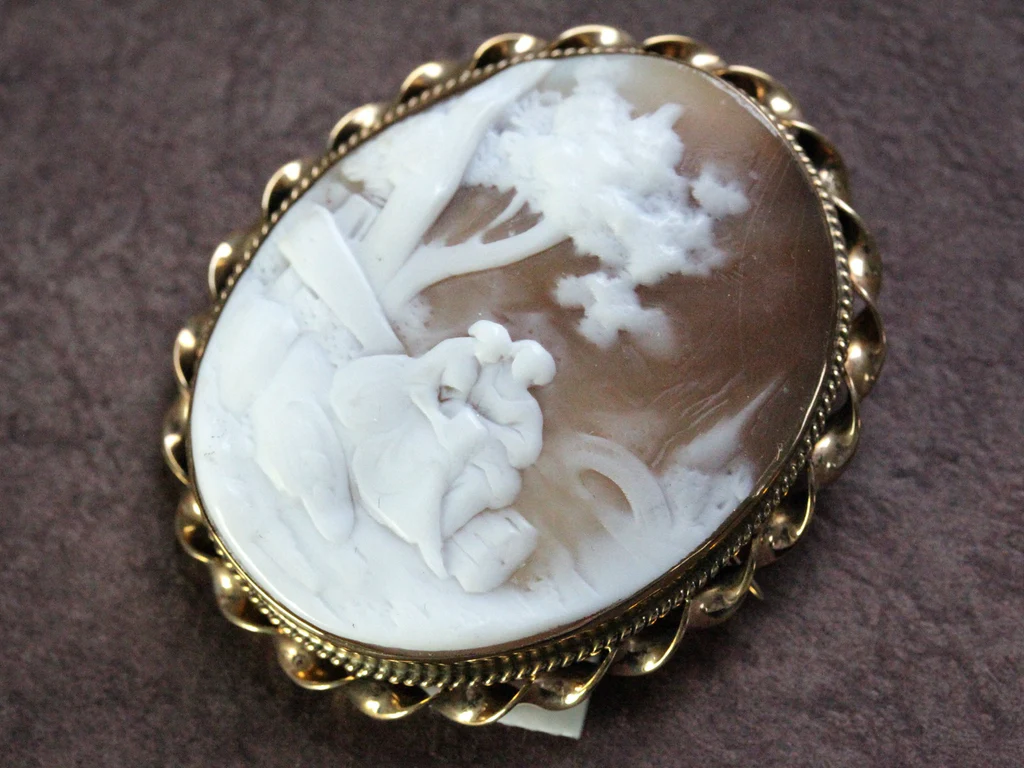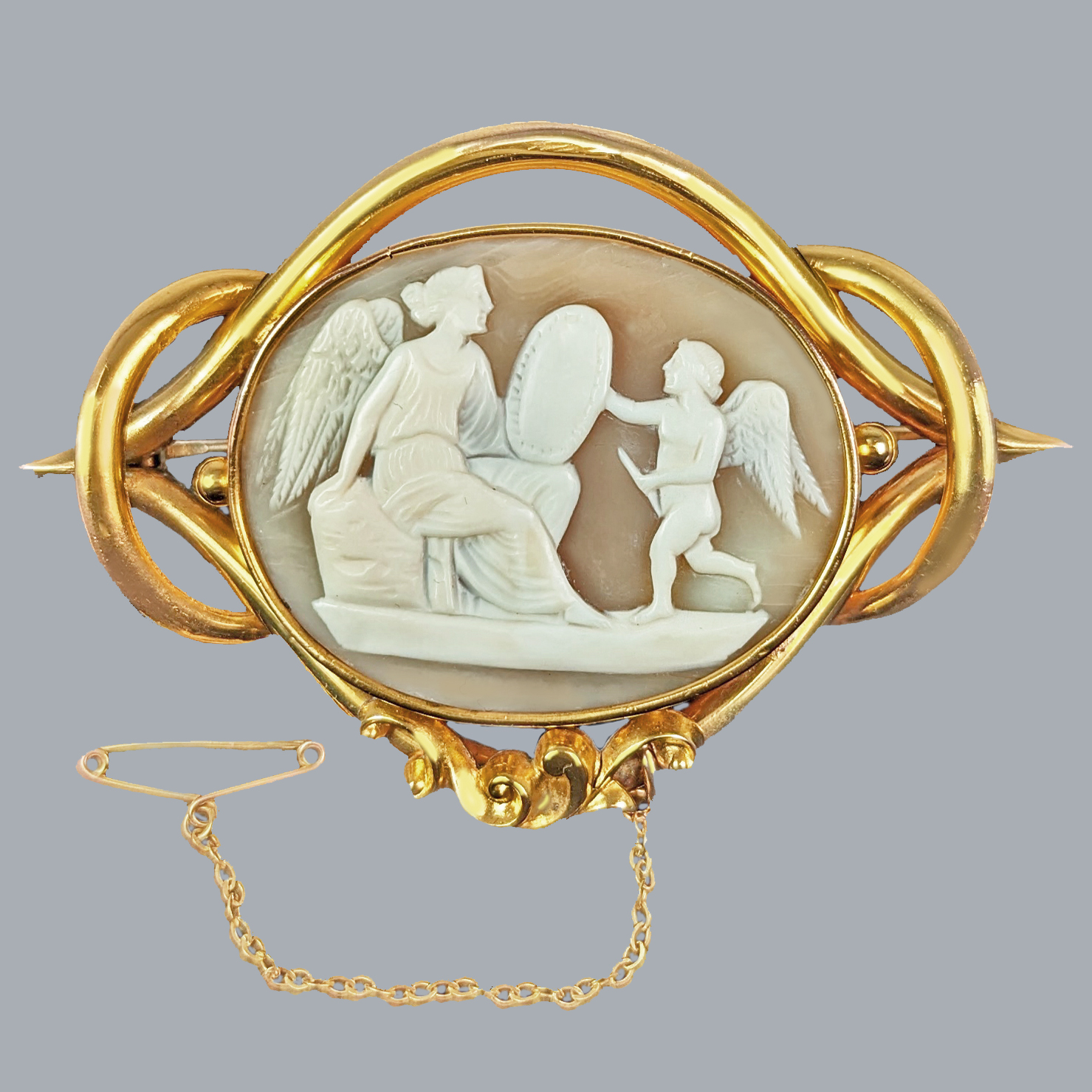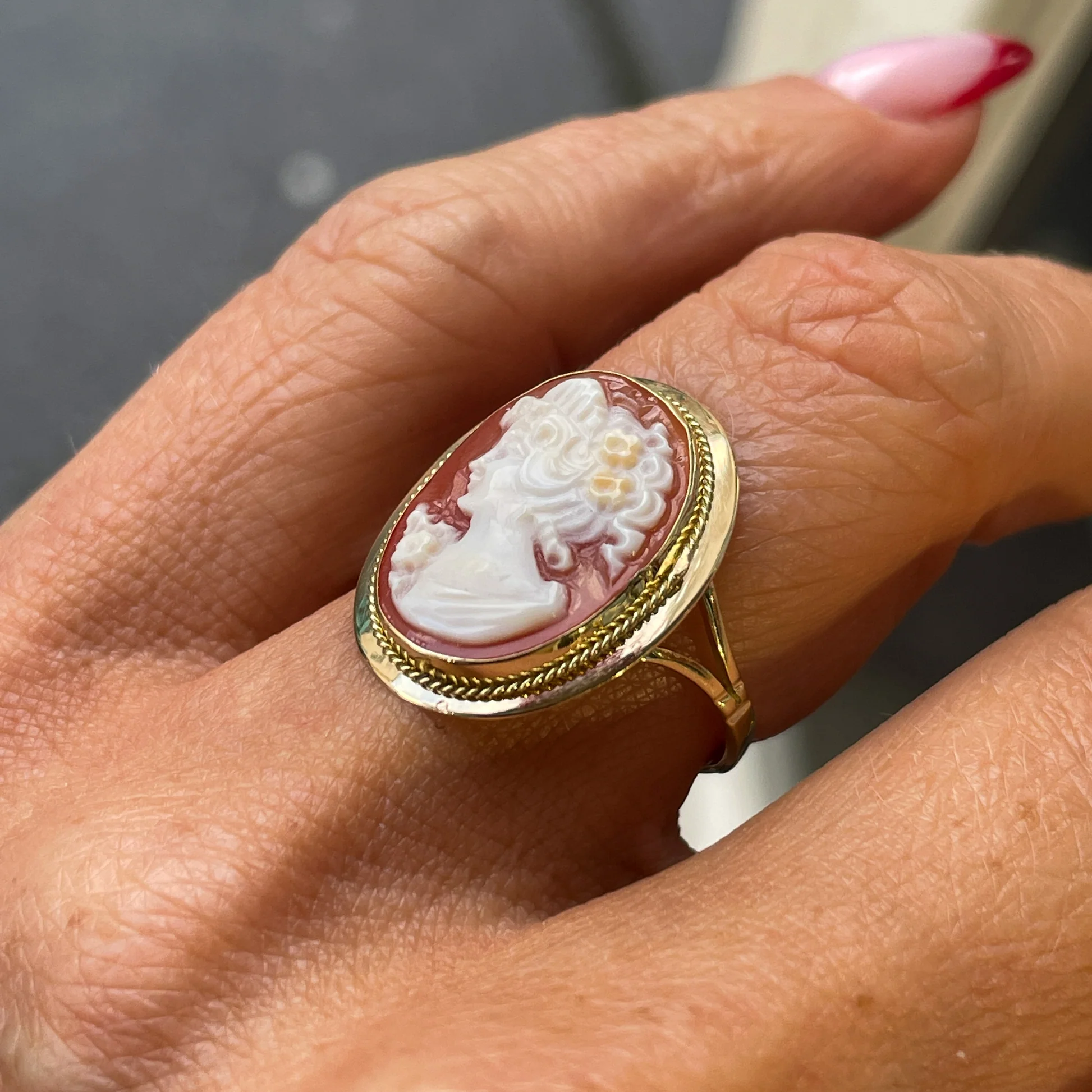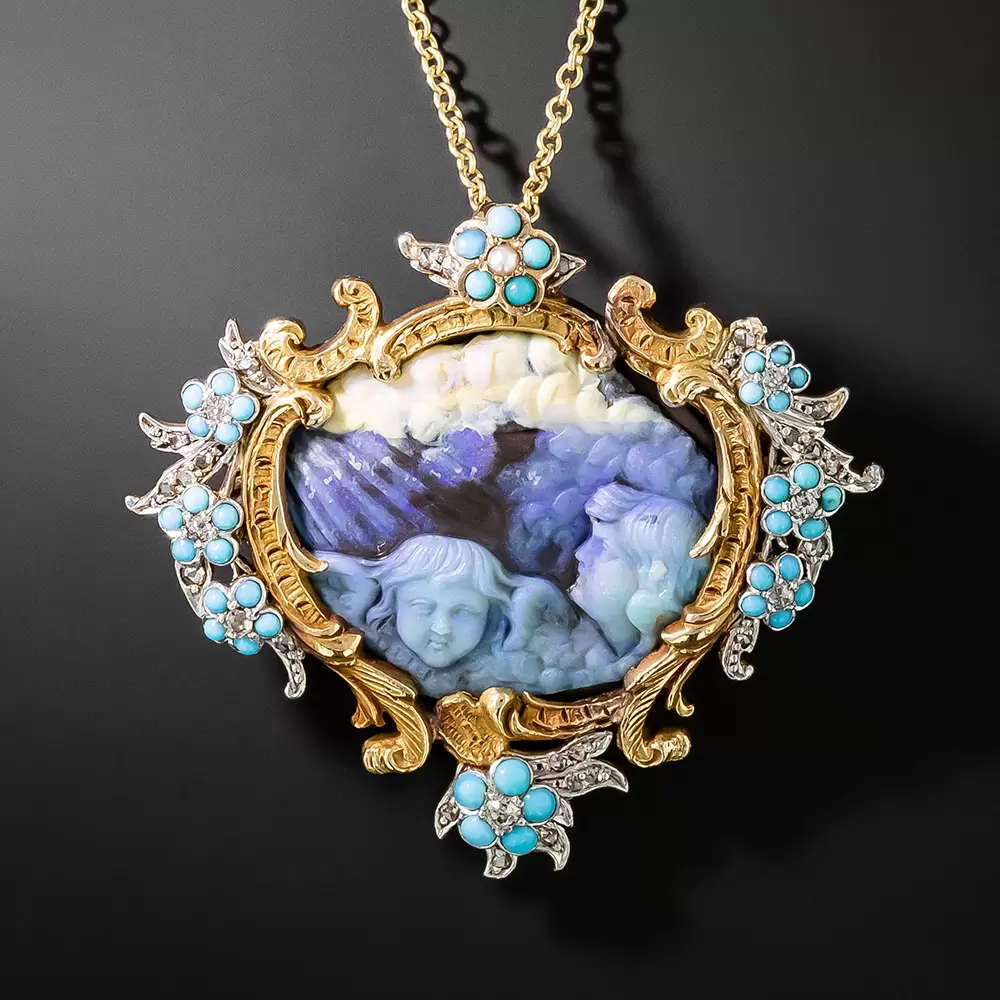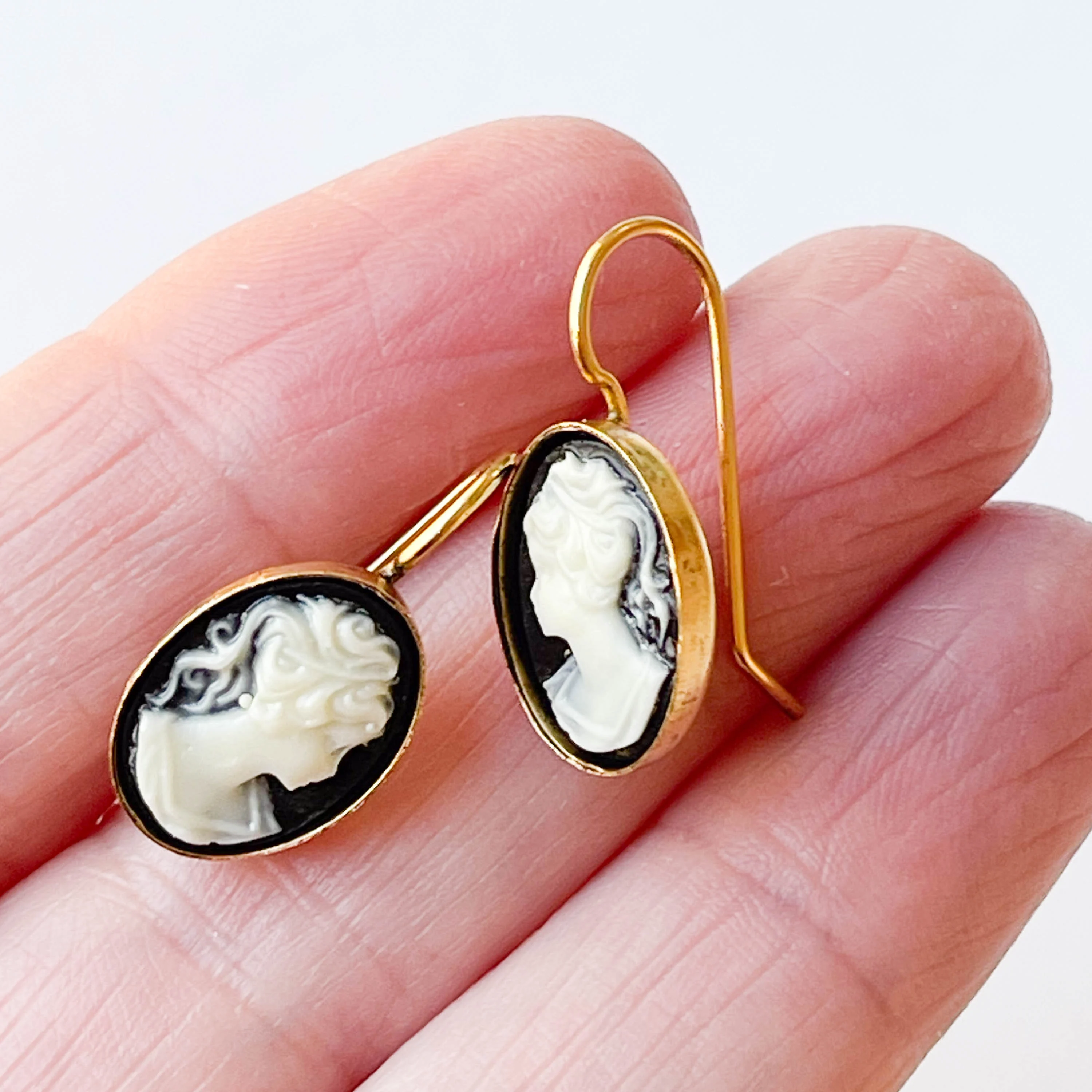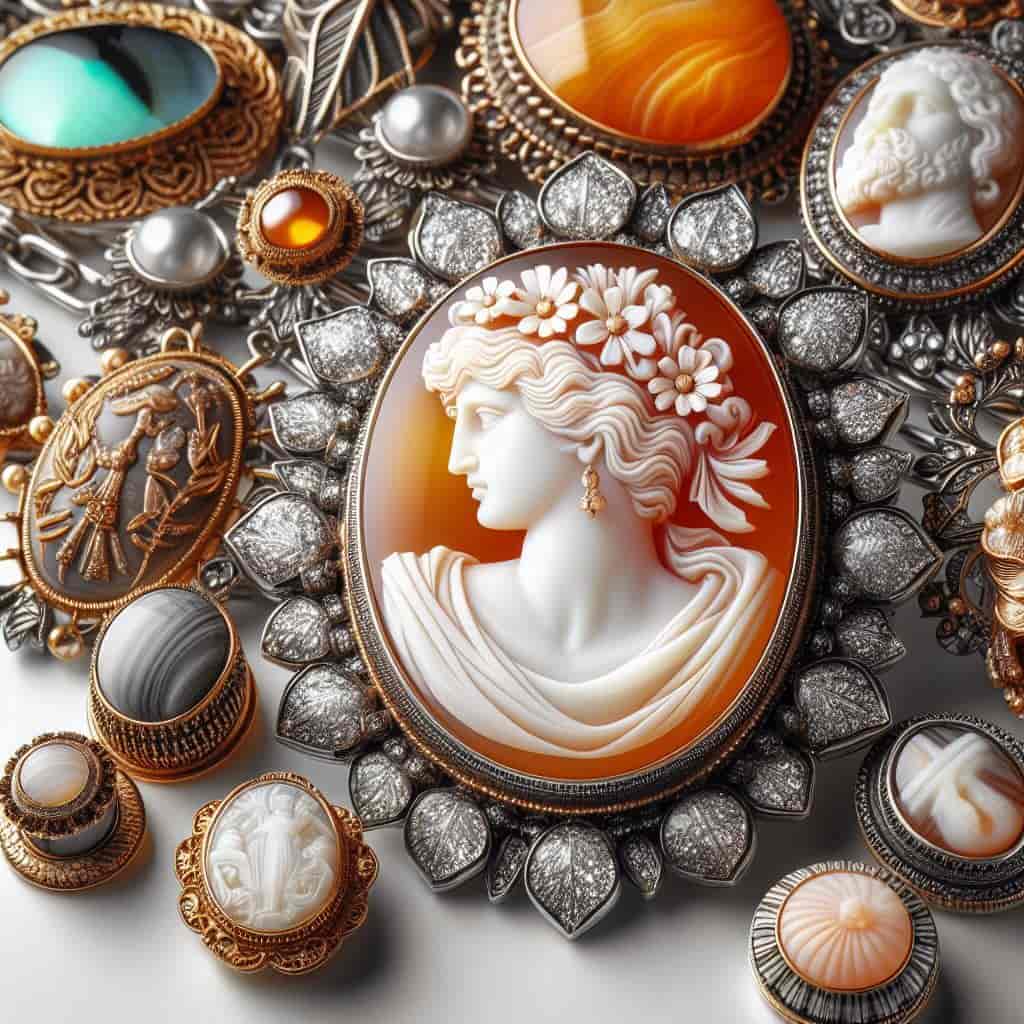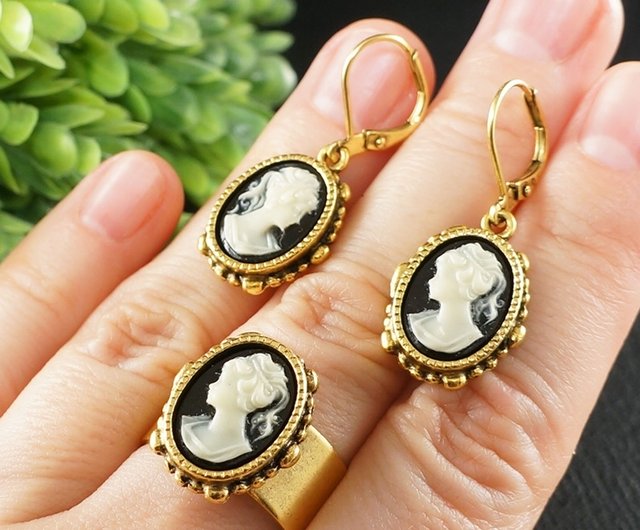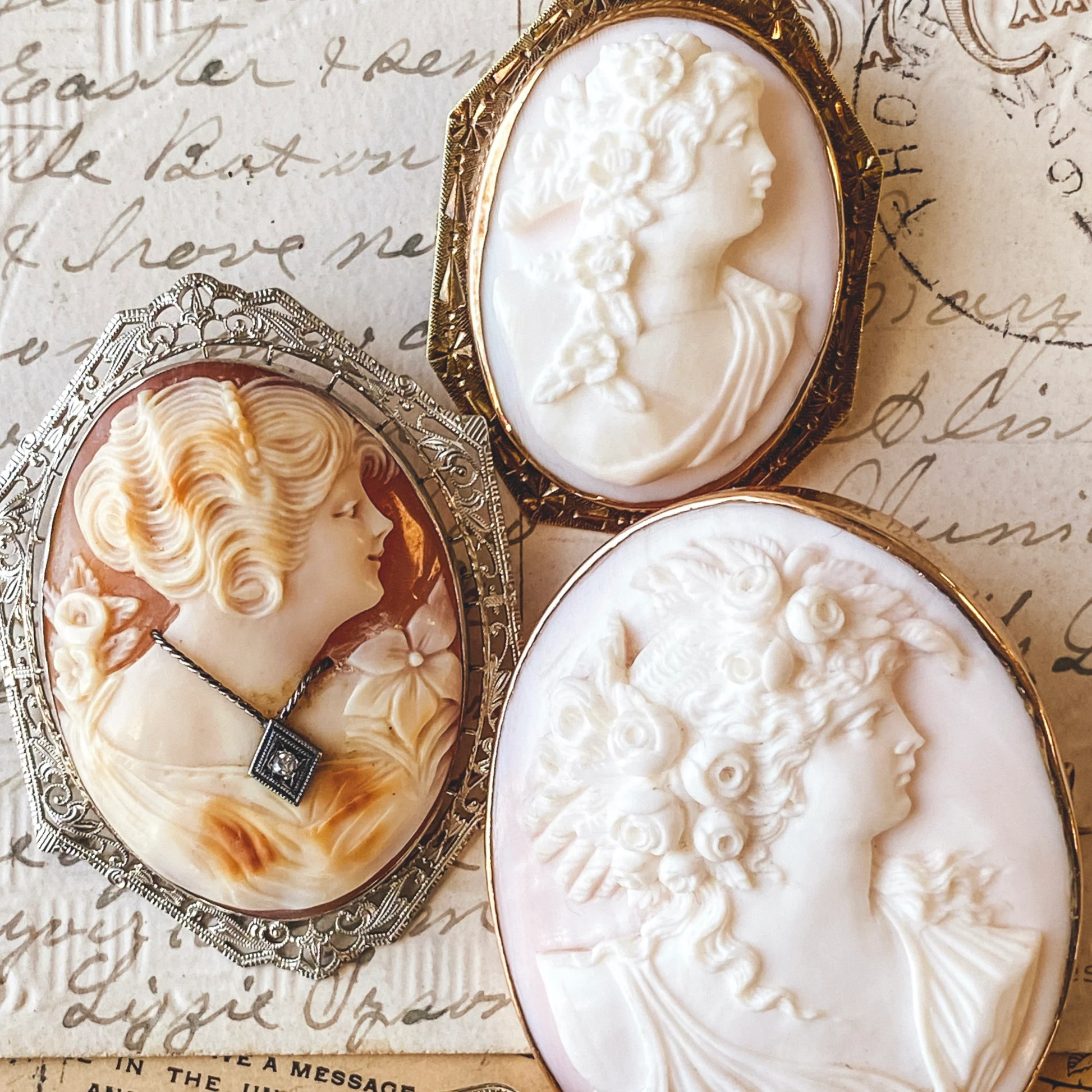
Cameo jewelryhas captivated admirers for centuries with its intricate craftsmanship and historical significance. Featuring carved images of gods, goddesses, and historical figures, these pieces offer more than just beauty; they tell stories of power, romance, and culture that have stood the test of time.
From ancient civilizations to modern fashion, cameo jewelry continues to fascinate. This article will discuss its rich history, craftsmanship, and enduring appeal, providing a deeper appreciation for these timeless works of art.
What Is Cameo?
Cameo jewelry is a distinct form of jewelry where a raised image is carved into a contrasting background. This intricate carving technique creates a three-dimensional design, typically featuring profiles of people, animals, or mythological figures. The carving is done on a variety of materials, most commonly shells, but also on gemstones, glass, or even coral. The contrast between the raised figure and the background enhances the detail and depth of the piece, making it visually striking.
Unlike other types of jewelry, cameos are not created with traditional casting or molding techniques. Instead, each piece is painstakingly hand-carved, making it a work of art in its own right. Cameo jewelry is often associated with classic beauty, with many designs featuring mythological, classical, or romantic themes. Much like platinum jewelry with engraving, cameo jewelry showcases the beauty of intricate craftsmanship and the timeless appeal of personal, artistic expression.
History Of Cameo Jewelry
Ancient Beginnings
Cameos trace their roots back to ancient stone carvings, which are believed to have had spiritual meaning. During the Roman Empire, artists carved images of gods, goddesses, and political figures into gemstonesand glass. These pieces were later sold to lower social classes, making them more accessible.
The Renaissance
During the Renaissance and Elizabethan times, cameos became popular among the elite. Noblewomen wore these carved gems to show off their wealth and social standing. Pope Paul II was known for wearing numerous cameo rings, so much so that some historians believe his constant cold hands from wearing them contributed to his death.
The 19th Century
Cameos reached new heights in the 1800s, with both Napoleon Bonaparte and Queen Victoria collecting them. Queen Victoria played a key role in making shell cameos popular because they were easier to carve than harder gemstones, making them more affordable. In addition, during this period, cameos made from hardened lava were sold as souvenirs for tourists visiting the recently uncovered ruins of Pompeii.
Napoleon’s Influence
Napoleon, often an unlikely style icon, saw the beauty of ancient Greek and Roman cameo craftsmanship and recognized how cameos could symbolize the power of France’s new republic, linking it to Roman grandeur. For his coronation, Napoleon ordered goldcrowns with cameos for himself and Josephine and even had furniture decorated with cameos. To meet the growing demand, he set up a cameo school in Paris, where French artists began to rival Italian makers in creating stunning cameos and cameo jewelry.
20th Century
In the 20th century, cameos became more affordable as costume jewelry gained popularity. The rich history and craftsmanship behind cameo jewelry made it a sought-after collectible, both vintageand antique. Replicas made from seashells, glass, and plastic brought the art form to a wider audience, offering a more budget-friendly option for those who admired the beauty of cameos. Many people also started giving cameos as gifts, making them a popular choice for jewelry anniversarycelebrations, where the timeless appeal of the piece symbolizes lasting loveand commitment.
How Cameo Jewelry Is Made
Cameo jewelry is crafted using a process known as "carving," a technique that requires skill, patience, and an understanding of the material’s unique properties. The creation of a cameo involves several important steps:
1. Material Selection
The first step in making a cameo is choosing the right material. Traditional cameos are carved from shells, with conch shells being a popular choice due to their smooth texture and natural color contrast. However, some cameos are made from harder materials like agate, coral, or even glass. Each material provides a different aesthetic and level of durability.
2. Design
After selecting the material, the artist sketches the design onto the surface of the material. This design typically includes a profile of a person, animal, or figure from mythology. In some cases, the design may be abstract or include floral patterns or intricate motifs.
3. Carving
The most crucial part of the process, carving, is done by hand using small tools like chisels and knives. The artisan carves away the material in layers to create a raised image against the background. The contrast between the image and the background is what gives the cameo its distinct, three-dimensional appearance.
4. Finishing Touches
Once the carving is complete, the cameo is polished to a smooth finish. This step is essential to ensure the details of the design are clear and visually striking. For materials like shell or coral, the piece is carefully cleaned to remove any debris and bring out the natural luster of the material.
5. Setting
The final step in creating cameo jewelry involves setting the carved cameo into a piece of jewelry. This could be a brooch, pendant, ring, or bracelet. The cameo is typically mounted in a metal frame, such as gold or silver, which adds durability and style to the piece.
Popular Types Of Cameo Jewelry
1. Cameo Brooches
Cameo brooches are often considered one of the most striking types of cameo jewelry. These pieces typically feature large, intricately carved designs, making them an ideal statement piece for both formal occasions and everyday wear. The brooches usually have a metal backing, and the cameo is framed in a decorative border, enhancing the visual impact.
The versatility of cameo brooches allows them to be worn in various ways pinned to a dress, scarf, or even a hat, instantly adding elegance and vintage charm to any outfit. They are particularly favored for their ability to showcase detailed artistry, with common designs including profiles of women, mythological figures, or floral patterns.
2. Cameo Rings
Cameo rings are smaller and often more delicate than brooches, making them a subtle way to incorporate vintage elegance into any outfit. These rings usually feature finely carved images that are set into a band, often with intricate detailing on the band itself. They are ideal for those looking to add a touch of antique style to their everyday wardrobe.
Cameo rings come in a variety of styles, from simple, understated designs to more ornate pieces with elaborate settings and stone embellishments. They often feature classic motifs like profiles of women, historical figures, or mythological scenes.
3. Cameo Pendants
Cameo pendantsare a timeless piece of jewelry, usually featuring a single cameo carved into a gemstone or shell and set into a metal frame. These pendantscan be worn as part of a necklace or as a standalone piece, allowing them to be paired with a variety of outfits, from formal gowns to casual wear. The pendant style highlights the cameo's beauty by framing it in a simple, elegant design.
The designs of cameo pendantscan vary widely, ranging from classic profiles to romantic or artistic representations. These pieces often feature delicate carving, which is visible when viewed up close, allowing the wearer to appreciate the fine artistry involved in their creation.
4. Cameo Earrings
Cameo earringscombine elegance and versatility, making them a popular choice for both everyday wear and special occasions. These earrings typically feature either a stud or drop design, with the cameo being set in a frame and attached to the earring backing.
The detail of the carved image stands out beautifully in these designs, adding a sophisticated touch to the overall look. Cameo earrings come in various styles, with studs offering a more understated, refined appearance and drop earringsproviding more movement and elegance.
What Determines The Value Of A Cameo Jewel?
1. Material Used For The Cameo
The material used to carve the cameo plays a significant role in determining its value. Traditional cameos were carved from materials like shell, coral, and agate, each with its unique appeal:
- Shell Cameos: Shell cameos are the most common and affordable type. They are made from various types of shells, such as conch or Sardonyx. While still beautiful, they are generally less expensive than those made from harder, rarer materials.
- Hardstone Cameos: Hardstone cameos, carved from materials like agate, onyx, and carnelian, are more valuable due to the difficulty involved in carving these durable stones. The harder the material, the more time-consuming and intricate the carving process becomes, driving up the value.
- Glass Cameos: These cameos are made from molded glass, often featuring a raised image similar to traditional hand-carved designs. While glass cameos can still be valuable, they tend to be less expensive than those carved from natural materials due to mass production.
- Coral Cameos: Carved from coral, these cameos are particularly rare and valuable because coral is a delicate material. The richness of the color and the quality of the carving can greatly impact its worth.
2. Craftsmanship And Carving Detail
The level of craftsmanship in a cameo can drastically affect its value. Hand-carved cameos, especially those with intricate details, are more valuable than machine-made ones. Skilled artisans use tiny, precise tools to carve images into the material, and the quality of the carving including the depth of the relief and the precision of the details adds to the piece's desirability.
High-quality cameos often depict complex scenes or profiles of mythological or historical figures, and the finer the detail, the more sought after the piece is. The depth and sharpness of the carving also contribute to the overall appeal, as more skilled artisans can create cameos with more defined, lifelike images.
3. Age And Rarity
The age of a cameo also plays a significant role in its value, with antique or vintage pieces being more valuable than newer creations. Cameos that date back to the Renaissance, Victorian, or Regency periods are considered especially rare and are highly sought after by collectors. The rarity of the cameo can also come from the era or historical figure it portrays.
For instance, cameos carved during the reign of a significant ruler, such as Queen Victoria, or during periods of artistic revival, like the Renaissance, can have increased value due to their historical significance. Rare cameo types or those made by famous cameo artists will also command higher prices.
4. Size And Condition
Larger cameos tend to be more valuable due to the level of skill required to carve larger, more detailed images. However, size alone doesn’t guarantee higher value — the quality of the craftsmanship is just as important. A small, finely carved cameo can often be worth more than a larger, poorly crafted piece.
Condition is another crucial factor. Cameos that are free from chips, cracks, discoloration, or other signs of damage are generally worth more than those that are damaged or worn. Even minor imperfections in a cameo’s carving or setting can reduce its market value significantly.
5. The Setting And Mounting
The way the cameo is set or mounted also influences its value. Cameos set in high-quality precious metals like gold or platinum, especially those adorned with gemstones, are more valuable than those set in base metals or simple settings. The design of the setting whether it’s vintage, ornate, or simple can enhance the cameo’s overall value.
Some cameos are set into intricate pieces of jewelry, such as brooches, rings, or necklaces. The overall design and rarity of the setting can add to the piece's allure, making it a more desirable and valuable collectible.
6. Popularity Of The Design
The specific design of the cameo also affects its value. Cameos that feature popular themes, such as portraits of well-known historical figures, romantic motifs, or mythological scenes, tend to be more valuable. The more universally recognized the design, the more likely it is to attract collectors.
Cameos depicting portraits of famous personalities like Queen Victoria, Napolean, or famous gods and goddesses from classical mythology are often highly valued. In contrast, less intricate or generic designs may not fetch as high a price.
How Can I Identify Genuine Cameo Jewelry?
1. Examine The Carving Technique
One of the easiest ways to distinguish a genuine cameo from a reproduction is by looking at the carving. Genuine cameos, particularly those that are antique or artisan-made, will have been carved by hand using small, precise tools. The carving should show intricate detail, with smooth transitions between raised and recessed areas.
If the piece is a true artisan creation, you may notice slight imperfections in the carving, such as tiny irregularities or tool marks, which are a characteristic of handcrafting. In contrast, mass-produced or modern cameos may have smoother, uniform carvings that lack the subtle imperfections that come with handwork.
2. Check The Material
The material of the cameo can provide insight into its authenticity. Antique and high-quality artisan cameos are typically made from natural materials such as:
- Shell: Conch or Sardonyx shell cameos were common in the Victorian era. The natural color contrast between the carved figure and the background is a telltale sign of authenticity.
- Hardstone: Cameos carved from stones like agate, onyx, or carnelian are more durable and were used in higher-end pieces. Hardstone cameos are usually more expensive due to the difficulty involved in carving them.
- Coral: Coral cameos are rarer and more valuable due to the material's delicate nature.
Glass or plastic cameos are often used for more modern or costume jewelry and are less valuable than those made from natural materials. Look closely at the surface of the cameo to determine if it’s shell, stone, or a synthetic material.
3. Inspect The Backing And Setting
Genuine antique and artisan-made cameos are typically set in high-quality metals like gold, silver, or even bronze. The setting is often intricate and can help verify the authenticity of the piece. Older cameos are frequently mounted in ornate frames with fine details that reflect the craftsmanship of the time.
If the backing of the cameo is made from inexpensive metal or shows signs of mass production (such as uniform, machine-made marks), it may indicate a modern or mass-produced piece rather than a genuine antique. Antique cameos may also feature hand-forged settings, which may include subtle variations from piece to piece.
4. Look For Artist Signatures Or Marks
Artisan-made cameos, particularly those from renowned makers, may have a signature or maker’s mark etched into the back or side of the cameo. This can be a symbol, a name, or initials that identify the artist or workshop responsible for the piece.
In the case of antique cameos, this might be harder to find, but certain famous cameo artists, particularly from the 19th century, are known for their distinctive styles. Researching the signature or mark can help confirm the authenticity of the piece.
5. Assess The Age And Patina
Antique cameos typically have a patina, or aged appearance, due to years of exposure to air and handling. The color of the cameo may be more muted, and the surface may show signs of wear, such as minor scratches or slight color changes. This patina adds to the character and historical value of the piece.
Modern cameos, especially those that are mass-produced, may appear too pristine or lack the depth of color that comes with age. If the cameo looks brand new, it may be a reproduction.
6. Study The Design And Theme
The design of the cameo can also help you identify its authenticity. Antique cameos often feature classical themes such as mythological figures, goddesses, or historical portraits. These themes were popular in ancient times, as well as during the Renaissance and Victorian periods. If the design seems overly simplistic, generic, or out of place for the era, it may not be an antique or artisan-made piece.
Victorian cameos, for example, often featured romantic or sentimental imagery, such as profiles of women, or classical figures inspired by ancient Greece and Rome. Researching the types of designs popular in various historical periods can help you identify the era in which the cameo was made.
7. Consult A Jewelry Expert Or Appraiser
If you are still unsure about the authenticity of a cameo, it’s always a good idea to consult a professional. Antique jewelers or certified appraisers specialize in identifying genuine cameos and can provide you with expert advice. An appraiser will assess the carving, material, age, and overall quality of the piece and give you a better understanding of its authenticity and value.
Caring For And Maintaining Cameo Jewelry
Cleaning Cameo Jewelry
To clean cameo jewelry, always use a soft, lint-free cloth to gently wipe away any dirt, oils, or residue. Avoid using harsh chemicals, abrasive cleaners, or scrubbing tools, as these can damage the delicate carvings or the surrounding setting. For pieces with built-up grime, lightly dampen the cloth with water, and ensure it's not soaking wet to prevent moisture from getting into the carving.
If necessary, you can use a mild soap solution but be sure to rinse it thoroughly with clean water afterward to avoid any soap residue. Always dry your cameo jewelry with a soft cloth immediately after cleaning. Regularly clean jewelryto maintain its beauty and ensure it stays in excellent condition for years to come.
Storage Of Cameo Jewelry
Proper storage is crucial to protect cameo jewelry from damage. Store your cameos in a soft, dry place away from direct sunlight, as prolonged exposure to sunlight can cause discoloration or fading of the material. Extreme temperature changes or high humidity can also affect the integrity of the cameo, potentially leading to warping or cracking.
To avoid scratches and other damage, it’s best to keep each piece in a separate, soft pouch, preferably lined with felt or velvet. If possible, store your cameos in a jewelry boxwith compartments to prevent them from rubbing against other pieces.
Handling Cameo Jewelry
Cameo jewelry features delicate carvings that are vulnerable to chips, scratches, or other damage if not handled carefully. Always handle your cameo pieces with clean hands and avoid applying pressure to the carved areas. When putting on or taking off cameo jewelry, do so gently and avoid pulling or tugging.
If your cameo is mounted on a ring or brooch, take extra care not to knock it against hard surfaces, as the intricate carving can be easily damaged. Additionally, try to avoid wearing cameo jewelry during activities that could expose it to rough treatment, such as cleaning, gardening, or physical exercise.
FAQs
What Makes Cameo Jewelry Valuable?
Cameo jewelry’s value comes from the materials used, the craftsmanship involved, and the historical significance of the piece. Hand-carved cameos are especially valuable, and vintage or antique cameos can fetch high prices due to their rarity and uniqueness.
How Can I Tell If A Cameo Is Real Or Fake?
Authentic cameos are usually hand-carved, and you can often see slight imperfections in the carving. Fake cameos are typically made with mass-production methods, such as mold casting, and lack the fine detail of a hand-carved piece.
Are Cameos Still Popular Today?
Yes, cameos continue to be popular, particularly for vintage and antique jewelry enthusiasts. Modern designers have also reinterpreted the classic cameo style, making it a fashionable statement piece in contemporary designs.
What Should I Look For When Buying Vintage Cameo Jewelry?
When buying vintage cameo jewelry, check the quality of the carving, the material used, and the overall condition of the piece. Authentic cameos will often have slight imperfections due to the hand-carving process.
Final Thoughts
Cameo jewelry remains a symbol of elegance and history, blending artistry with heritage. Antique or modern, cameos continue to captivate collectors and fashion lovers, offering a timeless connection to the past. These exquisite pieces not only enhance any collection but preserve stories of ancient civilizations and royal grandeur for generations to come.
